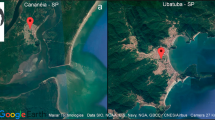Abstract
The composition of fatty acids (FAs) of a green alga (Ulva intestinalis) inhabiting small rivers of the Elton Lake basin has been investigated. It has been established that long-chain FAs with 16 and 18 carbon atoms are essential. We have investigated the composition variability of FAs of lipids of U. intestinalis depending on environmental factors: the level of mineralization, temperature, oxygen saturation, and acidity. It has been revealed that FA nonsaturation increases with an increase in mineralization. We assume that ω-6 and ω-3 desaturases participate in the adaptation of U. intestinalis to this factor.
Similar content being viewed by others
References
Vinogradova, K.L., Ul’vovye vodorosli (Chlorophyta) morei SSSR (Green Algae (Chlorophyta) in the Seas of USSR), Leningrad: Nauka, 1974.
Evstigneeva, I.K. and Grintsov, V.A., Quantitative development and species diversity of macroalgae on artificial substrate in the Black Sea, Ekol. Morya., 2001, no. 55, pp. 11–17.
Alstroem-Rapaport, C. and Leskinen, E., Development of microsatellite markers in the green algae Enteromorpha intestinalis (Chlorophyta), Mol. Ecol. Notes., 2002, vol. 2, no. 4, pp. 581–583.
Zhizn’ rastenii (Life of the Plants), Gollerbakh, M.M., Eds., Moscow: Prosveshchenie, 1977, vol. 3.
Martins, I. and Marques, J.C., A model for the growth of opportunistic macroalgae (Enteromorpha sp.) in tidal estuaries, Estuarine, Coastal Shelf Sci., 2002, vol. 55, no. 2, pp. 247–257.
Los’, D.A., Structure, regulation of expression, and activity of fatty acid desaturases, Usp. Biol. Khim., 2001, vol. 41, pp. 163–198.
Larcher, W., Physiological Plant Ecology, Berlin: Springer, 2003, 4th ed.
Zunzunegui, M., Cruz Diaz Barradas, M., Ain-Lhout, F., Alvares-Cansino, L., Esquivias, M.P., and Garcia Novo, F., Seasonal physiological plasticity and recovery capacity after summer stress in Mediterranean scrub communities, Plant Ecol., 2011, vol. 212, pp. 127–142.
Alaudinova, E.V. and Mironov, P.V., Meristematic lipids of forest-forming coniferous in Central Siberia affected by low temperatures. 2. Metabolic peculiarities of fatty acids in phospholipids in meristems of Lapix sibirica Ledeb., Picea obovata L. and Pinus sylvestris L., Khim. Rastit. Syr’ya., 2009, no. 2, pp. 71–76.
Cartea, M.E., Migdal, M., Galle, A.M., Pelleiter, G., and Guerche, P., Comparison of sense and antisense methodologies for modifying the fatty acid composition of Arabidopsis thaliana oilseed, Plant Sci., 1998, vol. 136, pp. 181–194.
Rozentsvet, O.A. Nesterov, V.N., and Bogdanova, E.S., Influence of abiotic factors on the lipid composition of Ulva intestinalis (L.) link (Chlorophyta) in small rivers of the El’ton Lake basin of the Caspian lowland, Inland Wat. Biol., 2012, vol. 5, no. 2, pp. 214–221.
Atlas pochv SSSR (Soil Atlas of USSR), Kaurichev, I.S. and Gromyko, I.D., Eds., Moscow: Kolos, 1974.
Jacoby, B., Mechanisms involved in salt tolerance of plants, in Handbook of Plant and Crop Stress, Pessarakli, M., Ed., New York: Marcel Dekker, 1999, pp. 97–123.
Munns, R., Comparative physiology of salt and water stress, Plant Cell Environ., 2002, vol. 25, pp. 239–250.
Aleksin, O.A., Semenov, A.D., and Skopintsev, B.A., Rukovodstvo po khimicheskomu analizu vod sushi (Handbook on Chemical Analysis of Land Waters), Leningrad: Gidrometeoizdat, 1973.
Bligh, E.G. and Dyer, W.J., A rapid method of lipid extraction and purification, Can. J. Biochem. Physiol., 1959, vol. 37, pp. 911–917.
Kobzar’, A.I., Prikladnaya matematicheskaya statistika. Dlya inzhenerov i nauchnykh rabotnikov (Applied Mathematical Statistics for Engineers and Scientists), Moscow: Fizmatlit, 2006.
Thompson, G.A., Lipids and membrane function in green algae, Biochim. Biophys. Acta, 1996, vol. 1302, pp. 17–45.
Romanenko, V.,D., Osnovy gidroekologii (Basic Hydroecology), Kiev: Geneza, 2004.
Khotimchenko, S.V., Lipidy morskikh vodoroslei-makrofitov i trav. Structura. Rasprostranenie. Analiz (Lipids of Marine Algae-Macrophytes and Grasses. Structure. Distribution. Analysis), Vladivostok: Dal’nauka, 2003.
Ivanova, A., Nechev, J., and Stefanov, K., Effect of soil salinity on the lipid composition of halophyte plants from the sand bar of Pomorie, Gen. Appl. Plant Physiol., 2006, special issue, pp. 125–130.
Author information
Authors and Affiliations
Corresponding author
Additional information
Original Russian Text © V.N. Nesterov, O.A. Rozentsvet, E.S. Bogdanova, 2013, published in Sibirskii Ekologicheskii Zhurnal, 2013, No. 4, pp. 585–592.
Rights and permissions
About this article
Cite this article
Nesterov, V.N., Rozentsvet, O.A. & Bogdanova, E.S. Influence of abiotic factors on the content of fatty acids of Ulva Intestinalis . Contemp. Probl. Ecol. 6, 441–447 (2013). https://doi.org/10.1134/S1995425513040070
Published:
Issue Date:
DOI: https://doi.org/10.1134/S1995425513040070




